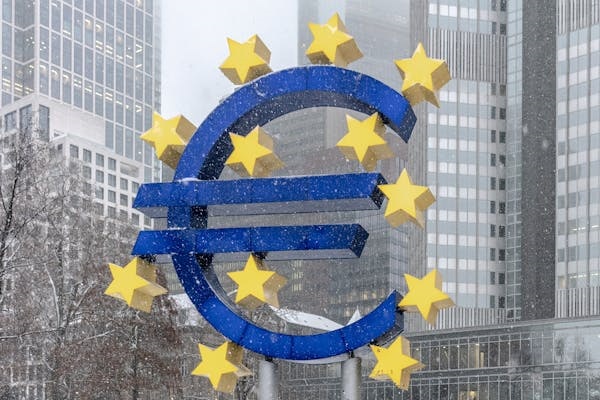As widely expected, the Governing Council of the ECB cut its deposit facility rate by 25 basis points to 3.75% at today’s meeting.
In early reaction, Des Lawrence, senior investment strategist at State Street Global Advisor said: “The move was well signalled and markets are more focused on indications on the number and timing of further rate cuts between now and year end. President Lagarde will want to strike a balance that tempers excessive rate cutting expectations seen earlier this year but also acknowledging the ongoing restrictive policy stance and transmission effects.
“Although inflation expectations remain quite well anchored, recent hard data has not been entirely helpful to those of a more dovish persuasion – early estimates for the month of May showed inflation increasing by more than forecast by markets. Admittedly this is just one datapoint and it won’t jeopardise the overall direction of travel for the central bank. Nevertheless, it does remind markets that the last leg of the disinflation journey can be the most difficult – services price inflation is still running at an annual rate of just over 4%.
“The ECB would like to have greater confidence that inflation is converging sustainably towards target as it embarks on rate cuts. It looks like it may take a little longer for that confidence to increase sufficiently to allow it to relax policy further. The ECB’s latest macroeconomic forecasts are also being published today and will be closely scrutinised for any significant changes in key projections. We may be entering a holding phase in the coming months but we do expect further policy easing by year end assuming the disinflation trend continues as we expect.”
Kaspar Hense, senior portfolio manager at RBC BlueBay Asset Management said: “The ECB has cut rates as expected to 3.75% after having been at the highest level since its existence for more than half a year. Even though headline inflation has come down significantly, we do not expect a cutting cycle to follow. While Europe has been hit even more so by the increase in gas prices after the Russian invasion into Ukraine, these base effects have indeed faded nicely.
“On one hand, we believe that growth will remain solid this year due to real disposable income turning positive and expectations around more fiscal unity after the EU election in H2. However, on the other hand, we think that the unemployment rate will remain low, or even go lower from here, with military spending (and in some cases compulsory military service) driving youth unemployment rate even lower. This we anticipate will result in leaving core inflation around 2.5% for the coming 12 months.”
Susannah Streeter, head of money and markets, Hargreaves Lansdown said: ‘’The European Central Bank has, as widely predicted, cut the eurozone’s key interest rate to 3.75%, moving faster than the Bank of England and the Federal Reserve. The reduction will come as a relief for many consumers and companies, whose finances have been stretched to breaking point by the rapid ratcheting up of interest rates. But ECB policymakers are expected to hit the pause button now, as sticky inflation has returned as a worry. While rates went straight up like a rocket, they look likely to descend in bumpy fashion.
“Financial markets have been pricing in two to three rate cuts in total by the ECB by the end of the year, but it’s looking unlikely that that policymakers will vote for another move lower next month. Caution is set to stay the name of the game, as they await fresh indications about inflation’s path. Headline inflation went in the wrong direction at the last count, heading away from the ECB’s 2% target. It rose by 2.6% year-on-year in May, compared to 2.4% for the previous two months, a larger increase than expected. Prices in the services sector, seen as a good indicator of domestic demand, also jumped to 4.1% from 3.7%.
“However, the overall direction of travel is clear – and it’s downwards. The ECB decision will raise hopes that UK interest rates will also be brought down sooner rather than later. The data coming in over the past few days has been more positive for the Bank of England, indicating that price pressures are easing. So an interest rate cut in August is still a very real possibility, although the financial markets have not been fully pricing in a cut until November.
She continued: “The Eurozone is in the recovery stage, with growth rising by 0.3% in the first three months of the year, after six quarters of stagnation or contraction. Unlike previous economic rough patches, firms have retained workers – with unemployment now at an all-time low. This means that stubborn pay growth remains a concern for policymakers, following a rise in negotiated salaries.
“There are concerns that it could feed further into higher prices, which is why policymakers are expected to stay more cautious in the months ahead.
“If higher borrowing costs persist, this is set to have a further knock-on effect on the bloc’s economy, which is only just on the mend. Unemployment is forecast to rise, which may help ease pay pressures, but could cause a fresh weakening in economic activity. Even if interest rates creep down again later this year, as expected, it may not stop further problems for the commercial property sector, given the jump in refinancing costs that many firms will still be facing.
“The International Monetary Fund has warned that Europe’s lacklustre growth prospects risk causing economic instability. On the face of it, European economies are constrained by growing deficits and strict rules on borrowing, which makes it difficult to spend big to boost fragile economies.
“This is especially the case given the demands on budgets from increased military spending and the need to support the green transition to meet agreed targets. Eleven countries, including France, Italy and Belgium, had deficits last year above 3% of GDP, the official high limit for debt. But there may be some room for manoeuvre given new rules that give a four-year grace period, with an option of extending to seven years – if governments show they are making investments aimed at boosting growth in the economy.’’
Lindsay James, investment strategist at Quilter Investors: “The starting gun has been fired and the European Central Bank is the first out of the major three banks to start cutting rates. This is a significant move given it is the first rate cut from the ECB in five years, and ends what has been one of the most aggressive and swift rate hiking cycles in modern times.
“Importantly, this is not likely to be a single cut and done for a while, with signals suggesting a further cut or two are on the horizon this year as inflation has subsided. The ECB has stolen a march on the Bank of England and Federal Reserve – who are both potentially still a few months away from cutting – and will breathe life into an economy that desperately needs some form of stimulus.
“While this news was well expected, it will no doubt provide relief to consumers and businesses on the continent. Ever since Russia’s invasion of Ukraine, Europe has struggled to combat the economic shock this produced, but signs are now improving, although uneven across the continent. While inflation has ticked up in recent months, the economic recovery is beginning to play out. This puts the ECB in a good position to cut further into a slowly improving picture, although the messaging is likely to remain restrained and cautious. As such, there may be some pauses on the way back down for rates in order to limit the scope of any divergence with the Federal Reserve.
“This move also focuses eyes on the BoE, who will make its decision in a couple of weeks. The major central banks will not want to diverge too far from one another, and with political risk being ratcheted up, they also won’t want to be seen as too influential.”
Ben Nichols, interim managing director of RAW Capital Partners, said: “The ECB’s decision will resonate with consumers and investors not just in the EU, but globally. While the impact of the cut is unlikely to be felt immediately, the move adds to the growing feeling that the global economy has turned a corner, and should provide some impetus to the Eurozone’s business investment, consumer spending and housing markets. We could also see investor sentiment experience something of an uptick in the aftermath of this decision, which could instigate a pick-up in global trade and investment.
“However, the risk remains that the ECB is cutting rates too early, and it will be intriguing to see if the US Federal Reserve and Bank of England follow suit in the coming months. The outlook for energy prices is unreliable and geopolitical conflict in Europe and the Middle East could create major challenges further down the line. What’s more, the Eurozone’s labour market remains surprisingly strong. Therefore, a rekindling of inflationary pressures remains a significant risk factor if the bank cuts rates too quickly.
“As a result, investors must watch on with keen interest. The challenge remains ensuring that portfolios can withstand any turbulence that arises from central banks’ interest rates decisions by diversifying across a range of uncorrelated asset classes, territories and sectors. This includes building a portfolio of both traditional and alternative investments, which will help reduce volatility, provide down-side protection, and protect recent gains.”





